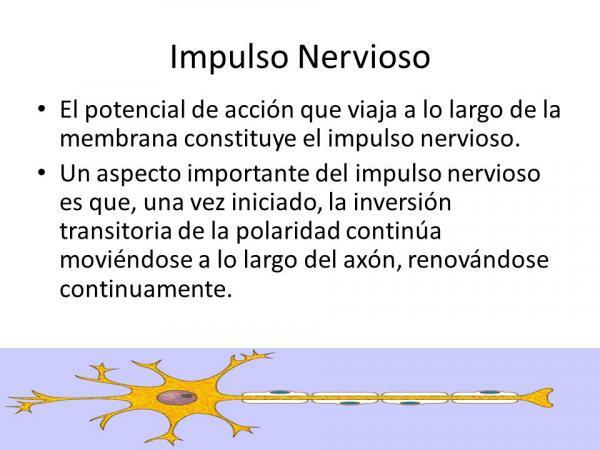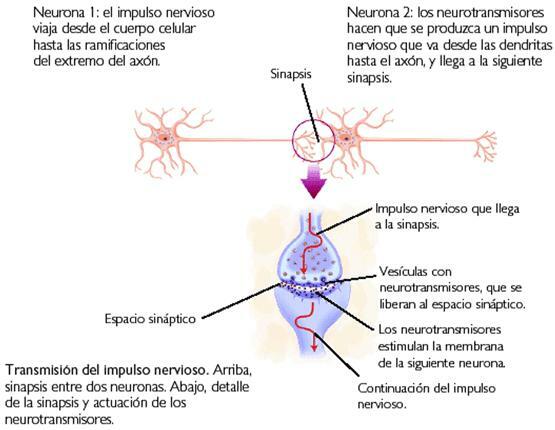What is NERVOUS IMPULSE and how does it spread

Nerve impulse It is the electrochemical signal by which neurons communicate. Thanks to this nerve impulse, neurons transmit information throughout the nervious system. In this lesson from a TEACHER we will see what is nerve impulse, how is it generated and howit spreads along a neuron and between neurons. We will also discover the fundamental role of the cell membrane of neurons in this whole process.
The nerve impulse is a small discharge of electrical energy that is generated in the neuron soma, is transmitted throughout the axon to the terminal ends, where the synaptic buttons.
The nerve impulse is a short and strong signal that spreads in a unidirectional way (cannot go back). It is a wave ofelectric power which receives the name of action potential.
Electrical energy is the energy generated by the forces of attraction or repulsion between charged particles. In neurons, the charged particles that generate electrical energy are the ions present in the cytoplasm and the extracellular environment. The cell membrane of the neuron is responsible for generating the nerve impulse.

Image: Slideplayer
The cell membranes of neurons They are capable of generating the nerve impulse (electrical energy) thanks to these properties:
- Cell membranes are semi-permeableIn other words, they only allow some substances to pass while they are a barrier for most compounds. This makes it possible for the composition of the internal environment of the cell (cytoplasm) to be totally different from that of the environment that surrounds the cell (extracellular environment).
- The membranes have ion channels (transmembrane proteins) that allow the passage of specific ions. These can be open or closed.
In the case of neuron membranes, we find a special type of ion channel that opens or closes depending on the electrical changes that the membrane experiences. They are voltage-gated ion channels. These characteristics allow uneven distribution of positive and negative ions on both sides of the membrane. Generating a field of forces that receives the name of Membrane potential or voltage.
The membranes of neurons are capable of changing their membrane potential by transporting ions through ion channels. These changes translate into release of energy.
Theresting potential is the membrane potential (voltage) of a neuron at rest. This potential is slightly negative. This means that more positive ions accumulate on the outside of the cell than on the inside.
The negative value of the resting potential is due to the activity of the Sodium-Potassium pump. This ion channel pumps 3 sodium cations (Na+) out of the cell, while pumping 2 potassium ions (K+) inward.
When a dendrite (extensions of the neuronal soma) receives a stimulus changes in the membrane potential occur in the area that has received the stimulus. This small change in potential causes a sudden and abrupt change in the membrane potential. Is the call action potential or electrical impulse that consists of a series of ionic currents through the membrane that release electrical energy (as a small discharge).
The action potential or nerve impulse has several phases:
Depolarization
Initial phase of the nerve impulse. The small change in potential (voltage) produced by the stimulus opens the Na channels+ voltage dependent, which are sensitive to these changes.
The massive influx of Na ions occurs+ through these channels. At the same time the Na pump+/ K+ it stops working preventing the exit of these ions.
As a consequence of these two processes, the membrane potential becomes positive. Now there are more positive charges inside the cell than in the external environment. The polarity of the membrane has been reversed with respect to the cell at rest and now the inner face is more positive than the outer face.
Hyperolarization
The depolarization of the membrane causes the closure of the voltage-gated channels and the Na+ it stops entering the cell en masse. However the K channels+ they are open. These channels allow the exit of a large quantity of K ions+ to the cellular exterior. This massive outflow of K + causes the membrane to polarize again. The inner face of the membrane becomes negative again with an accumulation of negative charges greater than that which it presents under conditions of rest.
Repolarization
In the last phase of the action potential, the membrane recovers its conditions of rest by activating the Na + / K + pump to restore the distribution of charges inherent to the state of rest. Thus the emission of the electrical impulse ends and the membrane remains in a state of rest, ready to react to the arrival of a new stimulus.

Image: Google Sites
Finally, we are going to discover how the nerve impulse spreads and that, thus, you finish understanding the lesson to the fullest.
1. How the action potential is transmitted in the neuron
In neurons, once generated in neuronal soma, the action potential (electrical impulse) moves along the axon until it reaches the terminals (synaptic buttons) where it will cause the release of neurotransmitters into space synaptic.
The action potential generated at the point of the membrane that receives the stimulus, causes similar changes in the adjoining membrane fragment before disappearing.
In this way, a chain reaction that runs through the entire axon to its furthest terminations.
The transmission of the action potential occurs by the law of all or nothing. Therefore, the action potential remains constant throughout the entire path of the axon.
Transmission speed
The myelin sheath is a lipid covering that lines the axon in most neurons in mammals. This coating envelops the nerve fibers providing electrical insulation. This myelin sheath is made up of Schwann cells or oligodendrocytes that surround the axon of the neuron. The myelin covering is not continuous, but is interrupted by brief unmyelinated spaces called Ranvier's nodules.
Ranvier's nodules are the only membrane fragments in contact with the extracellular fluid of myelin neurons; they concentrate the sodium and potassium channels through which the ion exchange that characterizes the action potential takes place.
Depending on whether the neurons are myelinated or not, the transmission speed is different:
- In non-myelinated neurons (without myelin sheath) the transmission of the electrical impulse is carried out along the entire length of the axon, being a relatively slow process.
- In myelinated neurons the transmission of the stimulus occurs from jump mode, that is, in jumps between one Ranvier node and the next, considerably increasing the speed at which the electrical impulse is transmitted. In addition to increasing the transmission speed, the jump transmission has the advantage that it is more economical at the energy level.
2. How the action potential is transmitted between neurons
Neurons communicate with each other through specialized intercellular junctions called synapse.
At the synapse, the electrical impulse (action potential) that travels a neuron must transform transiently in a chemical signal to be able to bridge the small space of the synaptic cleft that separates the two neurons.
When the electrical impulse, which travels along the emitting neuron, reaches one of the synaptic buttons at the end of the axon; there is the release into the synaptic space of chemical messengers stored in the synaptic button vesicles.
These molecules reach their destination through the synaptic space and bind to the dendrite receptors of the receptor neuron.
This union triggers a new electrical signal in the receiving neuron, thus spreading the nerve impulse. This transmission of information is known as synaptic transmission.

